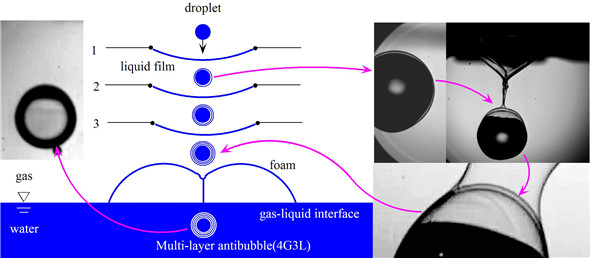The soap bubble, as is well known to us all, is a thin spherical liquid shell with gas inside and outside. It is not so well known that a reverse phase construction may exist: the antibubble-a thin spherical gas shell containing liquid inside and surrounded by liquid outside.
The formation of antibubbles is an important part and indispensable precondition of antibubble research and antibubble application. An ordinary way to generate antibubbles is to gently drip or pour a small amount of the same liquid over the gas-liquid surface. It is a difficult work and overflow is required to keep the surface very clean.
Recently, researchers BAI Lixin, XU Weilin, WU Pengfei et al. from the Institute of Acoustics of the Chinese Academy of Sciences have investigated formation of antibubbles and multilayer antibubbles experimentally by high-speed photography. A series of experiments were conducted to establish a link between soap bubbles and antibubbles. They have discovered a bran-new way to form antibubbles and multilayer antibubbles easily.

Fig. 1 The formation of antibubbles (Image by BAI Lixin et al.)
Liquid layers can help to generate antibubbles. A droplet passes through a liquid film before dropping to the gas-liquid interface. A special fluidic object is formed: the multilayer droplet -a droplet with several gas films and several liquid films in the outer shell.
The multilayer droplet (1G1L) falls on the gas-liquid interface, and another gas film is formed between the multilayer droplet and the interface. When the second gas film breakups, the liquid film of the multilayer mixes into water, and the droplet surrounded by a gas film sinks into the liquid becoming an antibubble.
A foam layer was produced on the surface deliberately in the experiment to generate antibubbles. It is found that a multilayer structure is formed between the droplet and the foam when the droplet passes through the foam layer. When the droplet falls into the interface of two foam bubbles (or plateau border) completely, two (or three) curved plateau borders are formed due to the existence of gas film.
The droplet surrounded by an air film and a liquid film moves downwards under the gravity. When the droplet falls to the bottom of the interface of two foam bubbles (or plateau border), the liquid film is opened, and the droplet surrounded by a gas film falls into the liquid. An antibubble is formed.
Combining the above two methods, multilayer antibubbles (as shown in Fig.1) can be generated. The droplet passes through several liquid films and becomes a multilayer droplet coated by several gas films and several liquid films. Then the multilayer droplet passes through a layer of foams and becomes a multilayer antibubble.
As far as it is known, this is the first report on the formation of antibubbles by foams. Regardless of the type of surfactant used, antibubbles can be easily formed by foams as long as there is a stable foam layer on the liquid surface. The authenticity of the existence of the multilayer antibubbles was verified.
Funding for this research came from the National Natural Science Foundation of China (No. 11674350, 11474305) and the National Basic Research Program of China (No. 2013CB035905).
Reference:
BAI Lixin, XU Weilin, WU Pengfei, LIN Weijun, LI Chao, XU Delong. Formation of Antibubbles and Multilayer. Colloids and Surfaces A: Physicochemical and Engineering Aspects (Vol. 509, 20 November 2016, pp. 334–340). DOI: 10.1016/j.colsurfa.2016.09.032
Contact:
BAI Lixin
Research Center for Ultrasonics and Technologies, Institute of Acoustics, Chinese Academy of Sciences, 100190 Beijing, China
Email: blx@mail.ioa.ac.cn


